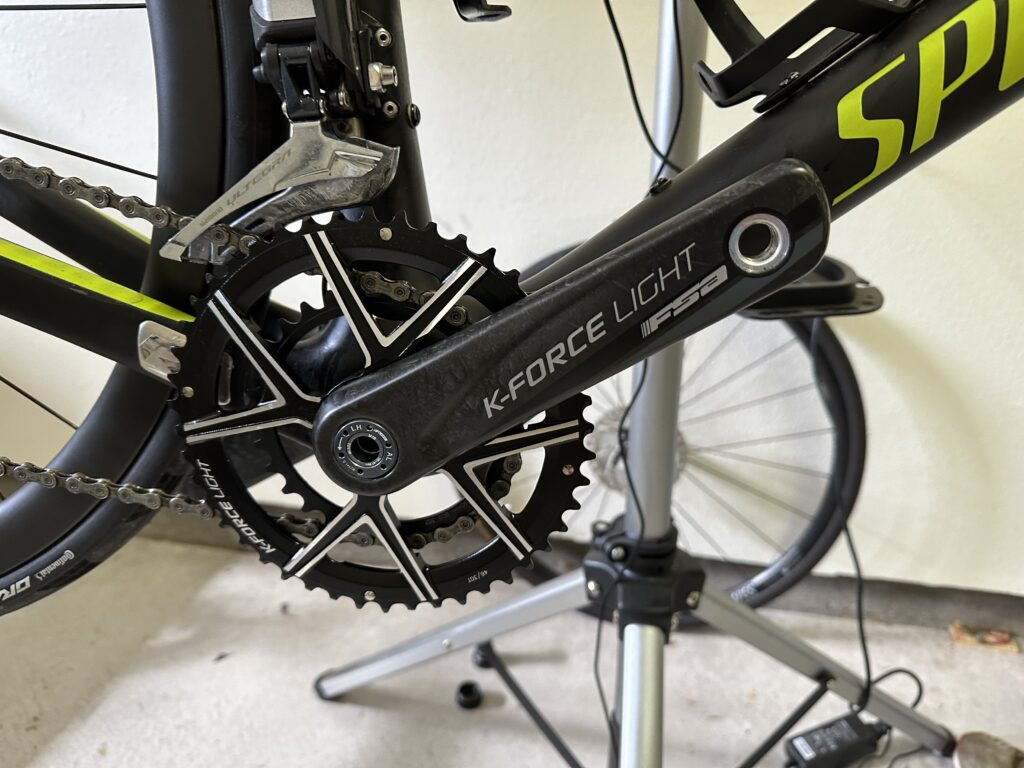I signed up for a gran fondo this summer that will have more climbing over 100 miles than I’ve ever done on a ride. I’m seriously concerned that I might not make it to the end, given the number of cat 1 and HC efforts required. So I decided to see if I could do something about the gearing on my bicycle. I have a OneNote page filled with interesting thoughts and links to products that might support this effort, but where I landed I think makes better general sense than what’s on most road bicycles today. So let’s start there.
The gearing on most road bikes today follows the Shimano pattern of 50/34 chain rings with cassettes ranging from 11-28 to 11-34. From a climbing perspective, your most powerful ratio is 1:1 (34/34). At the top end, you have the 50/11 combination. So what’s wrong with this? Originally, I had my triathlon bike and my road bikes configured this way (tri-bike 50/34 and 11-30, red road bike 50/34 with 11-28 and yellow road bike with 50/34 and 11-30). What I observed is that when I’m “on the flat” (which is never truly flat), I’m operating at barely in the middle of the cassette when I’m in the large chain ring and rarely do I ever use the small cassette cogs.
I always joke that the cleanest cog in my cassette is the 11T cog. Maybe I’m just not a fearless enough descender to really take advantage of it, but frankly having it is a waste. And the jumps between the cogs when I’m in the big chain ring are so large I find myself constantly struggling with a gear selection that’s a little too easy or a little too hard. So after a bunch of research, I’ve changed the gearing on one of my road bikes to see if it improved things.
I’ve updated my yellow road bike with FSA K-Force Light 46/30 cranks paired with an 11-34 cassette. The first question everyone will ask is – what did I lose by going with such a small set of chain rings? Only one thing – the equivalent of the 50/11 combo. The gear ratio of 50/11 is 4.55. The gear ratio of the 46/11 is 4.18, essentially the same as a 50/12 combination. It turns out that an 11-34 cassette jumps from an 11 to a 13 (there is no 12 on most of them), so the sacrifice is really small. But the benefit from the smaller 46T chain ring is that all of the gear ratios are closer making it easier to find the optimal gear to be in. For an 50T chain ring, the ratios for the top cogs are 4.55 to 3.85 to 3.33 to 2.94 to 2.63. With a 46T chain ring, the ratios are 4.18 to 3.54 to 3.07 to 2.71 to 2.43. While the numbers don’t look to dramatically different, the jumps are smaller with a smaller chain ring (the numerator is smaller) leading to a better road feel when trying to get into the ideal gear. With this setup, I find it easier to hit my power targets while spinning at a comfortable cadence.
On the climbing side, there’s the addition of a the 30/34 combination for a 0.88 climbing ratio. On an 11-34 cassette, the next cog up is a 30T, which is 1.0. The smaller chain ring leads to closer gear ratios for climbing as well, so instead of a jump from 1.0 to 1.13 to 1.26, I’m jumping from 0.88 to 1.0 to 1.11 to 1.2. Everything is tighter and better. And the extra climbing gear is great for when the grades go over 10%. Last weekend I did a ride with some unexpected climbing and plowed my way up a 10% hill with a crescendo of 13% at the finish. The gearing really helped and I wasn’t trashed at the top. Similarly, I did a really nice 60 mile ride yesterday with rolling hills and I never used the small chain ring until near the end where there was an actual climb. The entire ride felt strong.
So, in a sense, I’ve traded the 50/11 for a 30/34 but I actually think I got a whole lot more. I’m way more comfortable pedaling now and not finding myself stuck between too easy and too hard. Given my cycling strength (probably average for a dude my age), it’s not clear to me why Shimano persists in putting gearing on bikes that’s really not well suited for most riders. Strong riders will always find ways to move up but average riders will usually just stick with what they bought and be miserable. I think they are making the wrong choices here. SRAM is doing a better job with this – they are offering a wider variety of chain rings and cassettes, targeting their 46/33 chain rings and 10-33 cassette (12-speed) for someone like me. The new Roubaix Comp is equipped with SRAM 46/33 and a 10-36 cassette, which makes it similar to my bike, although I’m not sure why they decided 33 was a better number than 30 for their small chain ring.
As I continue to tinker, I may opt to go with an 11-36 cassette instead of the 11-34. The Shimano R8050-GS derailleur capacity is 37T, so a 46/30 and 11-34 cassette is 16 + 23 = 39T, so I’m already a little over spec but it’s working just fine. I actually think the capacity is incorrectly stated on the Shimano site since they indicate support for 11-34 cassette with this derailleur and they only offer cranks with a 16T delta. Wolf Tooth offers a derailleur extender to allow me to move to an 11-36 cassette. I’m a little concerned about pushing the derailleur capacity but I might give it a try since it’s an inexpensive change. The 11-36 cassette doesn’t match up exactly with the 11-34 so I’ll have to decide if I like the ratios I currently have:
11-36t: 11-12-13-15-17-19- 22- 25- 28- 32- 36
11-34t: 11- 13-15-17-19-21- 23-25-27- 30- 34But two sub-1.0 ratio climbing gears might be nice.
WIth my success here, I may also move my tri-bike to the same gearing, again driving for the same benefits I’m seeing on my road bike. I’ve already ordered the cranks for the red road bike and can’t wait to get it set up. To circle back, for the normal humans that are reading this, I encourage you to consider this setup as I think you’ll ultimately be a happier and more successful rider. Ride on!



